- NEW DVD Series – Stone Setting with Bezels
- Tube Set Charm by Kim St. Jean
- Prong Basket Pendant by Kim St. Jean
- NEW DVD Series – Stone Setting with Cold Connections
- New DVD Series – Stone Setting with Wire
- NEW DVD Series: Introduction to Stone Setting by Kim St. Jean
- Featured Tool: Bracelet Bending Plier
- NEW Dvd by Eva Sherman
- Fun, Fast Fold Forming DVD Series
- Double Band Ear Cuff from Alex Simkin
Gem Profile August 24: Iolite
by Rose Marion, Wire-Sculpture.com

Iolite
Find genuine gemstones on Wire-Sculpture.com
Iolite comes from the Greek "ios" for "violet", meaing violet stone, and is also found labeled as "water sapphire." Iolite is gem-grade cordierite, which is found all over the world. Corderite was found in 1813, and was named after a French geologist, Louis Cordier. Cordierite is often found in the same location with garnet, kyanite, andalusite, and other gem minerals. Iolite is pleochoric, which means that it can show different colors at different angles, especially under different polarized light. A well-cut iolite will show a beautiful blue color through the top of the stone, but it may appear violet, yellow, or colorless from a different angle!
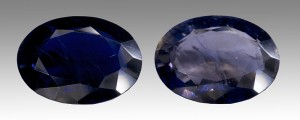
You can see the difference between the deep blue and the violet colors visible in the exact same gemstone in this photo, which is property of Didier Descouens.
Iolite is made up of magnesium, aluminum, and silicon (chemically, it’s known as magnesium aluminum silicate) and also sometimes has iron. Iolite rates a 7 to 7.5 on Mohs Scale, making it a tough stone, but the sources I read, including AGTA, cautioned to keep iolite gems away from high-traffic zones where it could get bumped or hits. This advice means iolite would be best for pendants and earrings, and not a good choice for bracelets or rings.
Iolite is found in several locations, including Brazil, Burma, India, Sri Lanka, and Africa. There is also a large deposit of iolite in Wyoming, discovered by Dan Hausel, a geologist at the University of Wyoming. He estimates that that area may contain over a trillion carats of iolite, in addition the gemstones he’s already uncovered, weighing over 24,000 carats each – wow! According to Hausel, this may make Wyoming home to the largest colored-gem deposit in the world.

Connie Drake wrapped these delicate iolite briolette beads into pendants with 22-gauge gold filled wire.
The Vikings are said to have mined iolite in Norway and Greenland, and while it hasn’t been proven, iolite is a candidate for the unknown stone called the Viking Compass, or the Viking Sunstone (used to locate the sun hidden behind obscuring mists – which also obscured perilous rocks and shorelines). Legend is that the Vikings used a gemstone to find their way in the frigid, foggy, northern waters. Iolite is said to guide lost sailors, and iolite is treasured as the stone for the 21st wedding anniversary.
Other blue-violet stones such as sapphire and tanzanite are more popular, but iolite can typically be found at a similar or often much-lower price. To care for iolite, a simple cleaning with warm soapy water and a toothbrush will remove any dirt or grime.
Next Friday’s Gem Profile is on Tanzanite. Have you made wire jewelry with tanzanite before? Send your tanzanite pictures to tips@wire-sculpture.com, and they could be featured!
Resources & Recommended Reading
- MinFind.com
- YourGemologist.com
- MinDat.org
- Iolite on AGTA.org
- Iolite found in Wyoming
- Lugaro Iolite
- Iolite – Viking Compass?
Gem Profile by Rose Marion
Click to Receive Daily Tips by Email







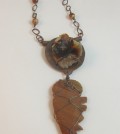
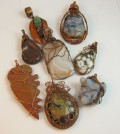

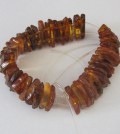

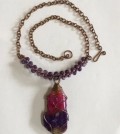
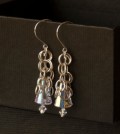
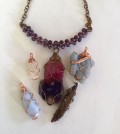
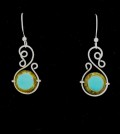
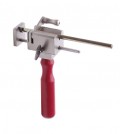
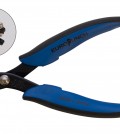
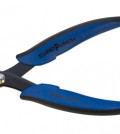
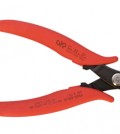
kirsten
August 24, 2012 at 6:19 am
in most of the “old world” Iolite was referred to as “water Sapphire”.
when you see references to Sapphire that was found in places that do not have notable deposits of corundum, its USUALLY Iolite.
the legend of a “sapphire that shone blue by day and violet at night” that was given as a rather cruel joke by a medieval lord to his lady (he told her it was a test of virtue and if it changed color she was unfaithful) may also have been Iolite. that, of course, is a legend…
Rose
August 24, 2012 at 8:41 am
Oh, how cruel! That does sound like iolite! Thanks for those interesting tidbits, Kirsten!
Gail Chambers
August 24, 2012 at 7:31 am
I just wanted to thank you for all the info and links in Gem Profile! I am putting together a folder of information to add to my display at shows…and I am still learning myself. What a great experience I am having being an avid follower of yours!
Rose
August 24, 2012 at 4:39 pm
Thanks, Gail! I truly appreciate it!
Lori Crawford
August 24, 2012 at 3:19 pm
I love these Gem Profiles Please keep them coming! They are so helpful.
Pingback: About Kyanite, the shimmering blue stone | Jewelry Making Blog | Information | Education | Videos